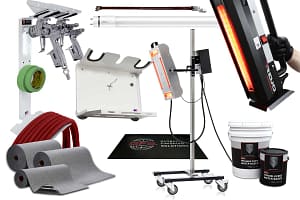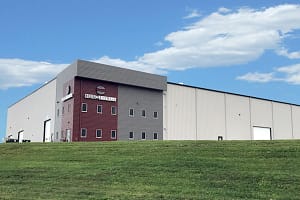
One of the simplest things you can do for the cleanliness and overall productivity of your paint booth is replacing intake and exhaust filters on a routine basis.
Clogged or overloaded filters hinder proper airflow. This causes dust or overspray to recirculate and affect the finish of your paint job. Regularly changing spray booth filters decreases the likelihood of equipment failure. It also helps ensure your spray booth is operating efficiently and keeps the production costs of your shop low.
A manometer can be used to measure a pressure differential, indicating when paint booth filters are loaded and need replacement. Monitoring the filters with your manometer lets painters and service personnel know when it is time to change the paint booth filters. If your spray booth does not have a differential pressure gauge, it is best to establish a strict maintenance schedule based on the time spent spraying in the paint booth.
“The most common maintenance mistake shops make is not following the paint booth manufacturer’s filter changeout schedule,” said Steve Love, Parts & Filters Sales Manager for Global Finishing Solutions (GFS). “Paint booth exhaust filters need to be changed every 100 operating hours or every three to four work weeks. Anything beyond that is putting your equipment at risk. Each paint operation is different, which may require changing exhaust media more frequently than every 100 hours.”
In addition to routinely changing the filters, it is important to select high-quality filters. The risk of taking short-term savings on cheaply made paint booth filters is higher than you might think.
While you may be saving money now, the cheaper quality of the materials will load with paint more quickly. This will cause more frequent filter changeouts. Low-cost alternatives also have a lower capture efficiency. That can lead to an even higher expense of replacing other parts, such as fans, motors and ductwork.
When selecting a paint booth exhaust filter material, make sure to choose the correct media for your application. The main goal of exhaust filtration is to protect the environment while preventing the buildup of overspray on system components. The EPA requires paint booth exhaust filters to be a minimum of 98 percent efficient.
Filters should hold enough paint to avoid constantly replacing them. When you use a low-grade paint booth filter, you risk higher operating costs related to additional filter changeouts, expensive fan repairs and production downtime.
Included with all GFS paint booths, GFS Wave exhaust filters have a holding capacity of 4.4 pounds. Paint-laden air is captured across the surface and within the depth of the media. This extends filter service life and reduces operating costs. GFS Wave filters are useful for a variety of paints and a wide array of spray applications, from clear coats to high solids.
It is also important to ensure your paint operation meets health and safety standards required by the NFPA and OSHA. In more severe situations, clogged filters may create flammable or explosive conditions. With so many different styles and brands, paint booth filters will reach their target reading and require replacement at varying rates. These rates depend upon the paint type, spray booth design, fan speed, temperature and spray equipment.
It is best to work with your paint booth manufacturer or filter supplier to design an effective replacement schedule for your filters. This schedule should balance your filtration and spray booth performance needs with the costs — and savings — of more frequent filter replacement. At GFS, we have an expert team of parts and filters sales representatives that can help with all your filter needs.
https://www.youtube.com/watch?v=eQw5ugt-xNo
One of the best ways to highlight your business is through a story that you can share across your online platforms. It humanizes your business and shows that your business can make a meaningful impact. Your testimonial would be used as a project profile on the GFS Booth Blog and can be shared on your website and/or social media channels.
Complete this form and we’ll be in touch to showcase your company.

Shop a variety of GFS aftermarket products, including booth protection products and mobile accelerated curing units. And enjoy the convenience of fast and free ground shipping throughout the contiguous United States.

Located at GFS’ headquarters in Osseo, Wisconsin, the Center for Excellence is an innovative facility featuring an automotive refinish training center, as well as a separate space dedicated to technical product training.

GFS is continuously searching for talented, ambitious individuals to join our team. We aim to provide our employees with every opportunity to make an impact on the company and find their niche along the way — weather in a production, field services or an office position.